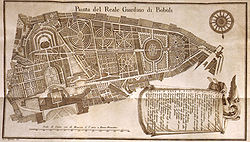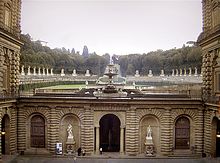Boboli Gardens
| Boboli Gardens | |
|---|---|
 The main axis through the anfiteatro centered on Palazzo Pitti | |
 | |
| Type | Pleasure garden |
| Location | Florence, Italy |
| Coordinates | 43°45′45.14″N 11°14′53.51″E / 43.7625389°N 11.2481972°E |
| Area | 45,000 square metres (11 acres) |
| Website | www |
The Boboli Gardens (Template:Lang-it) is a park in Florence, Italy, that is home to a collection of sculptures dating from the 16th through the 18th centuries, with some Roman antiquities.
History and layout

The Gardens, directly behind the Pitti Palace, the main seat of the Medici grand dukes of Tuscany at Florence, are some of the first and most familiar formal 16th-century Italian gardens. The mid-16th-century garden style, as it was developed here, incorporated longer axial developments, wide gravel avenues, a considerable "built" element of stone, the lavish employment of statuary and fountains, and a proliferation of detail, coordinated in semi-private and public spaces that were informed by classical accents: grottos, nympheums, garden temples and the like. The openness of the garden, with an expansive view of the city, was unconventional for its time. The gardens were very lavish, considering no access was allowed to anyone outside the immediate Medici family, and no entertainment or parties ever took place in the gardens.
The Boboli Gardens were laid out for Eleonora di Toledo, the wife of Cosimo I de' Medici.[1] The name is a corruption of "Bogoli", a family from whom land had been bought to construct the garden.[2] The first stage was scarcely begun by Niccolò Tribolo[1] before he died in 1550, then was continued by Bartolomeo Ammanati, with contributions in planning from Giorgio Vasari, who laid out the grottos, and in sculpture by Bernardo Buontalenti.[3] The elaborate architecture of the grotto in the courtyard that separates the palace from its garden is by Buontalenti.
The garden lacks a natural water source. To water the plants in the garden, a conduit was built from the nearby Arno River to feed water into an elaborate irrigation system.[1]
The primary axis, centered on the rear façade of the palace, rises on Boboli Hill from a deep amphitheater[3] that is reminiscent in its shape of one half of a classical hippodrome or racecourse. At the center of the amphitheater and rather dwarfed by its position is the Ancient Egyptian Boboli obelisk[1] brought from the Villa Medici at Rome. This primary axis terminates in a fountain of Neptune (known to the irreverent Florentines as the "Fountain of the Fork" for Neptune's trident), with the sculpture of Neptune by Stoldo Lorenzi visible against the skyline as a visitor climbs the slope.
Giulio Parigi laid out the long secondary axis, the Viottolone or Cyprus Road at a right angle to the primary axis. This road led up through a series of terraces and water features, the main one being the Isolotto complex, with the bosquets on either side, and then allowed for exit from the gardens almost at Porta Romana, which was one of the main gates of the walled city. In 1617, Parigi constructed the Grotto of Vulcan (Grotticina di Vulcano) along this axis.
The gardens have passed through several stages of enlargement and restructuring work. They were enlarged in the 17th century to their present extent of 45,000 meters² (111 acres).[3] The Boboli Gardens have come to form an outdoor museum of garden sculpture that includes Roman antiquities as well as 16th and 17th century works.
In the first phase of building, the amphitheatre was excavated in the hillside behind the palace. Initially formed by clipped edges and greens, it was later formalized by rebuilding in stone decorated with statues based on Roman myths such as the Fountain of the Ocean sculpted by Giambologna, then transferred to another location within the same garden. The small Grotto of Madama, and the Large Grotto, were begun by Vasari and completed by Ammannati and Buontalenti between 1583 and 1593.[3]
Even while undergoing restoration work in 2015, the Large Grotto's statues are still on display and represent defining examples of Mannerist sculpture and architecture. Decorated internally and externally with stalactites and originally equipped with waterworks and luxuriant vegetation, the fountain is divided into three main sections. The first one was frescoed to create the illusion of a natural grotto, that is a natural refuge to allow shepherds to protect themselves from wild animals; it originally housed The Prisoners of Michelangelo (now replaced by copies), statues that were first intended for the tomb of the Pope Julius II. Other rooms in the Grotto contain Giambologna's famous Bathing Venus and an 18th-century group of Paris and Helen by Vincenzo de' Rossi.
The Fountain of Neptune
In the hillside above the amphitheatre is a double ramp, leading to the Fountain of Neptune. The main feature is a large basin with a central bronze statue of Neptune (1565-1568) by Stoldo Lorenzi. This fountain was being constructed contemporaneously with it more famous counterpart, Ammannati's Fountain of Neptune at the corner of the Palazzo Vecchio at the Piazza della Signoria in the center of Florence. The conceit here recalls the story of the competition of Athena and Neptune to be patrons of Athens. In that legend, Neptune struck the ground with his trident to spring forth water from the land. Higher up on the hillside is a statue of Abundance (Dovizia).[4]
The Isolotto

The Isolotto is an oval-shaped island in a tree enclosed pond nearly at the end of the alternative Viottolone axis. In the centre of the island is the Fountain of the Ocean, while in the surrounding moat, there are statues of Perseus and Andromedae (school of Giambologna). The Isolotto was laid out (circa 1618) by Giulio and Alfonso Parigi.
Gallery
-
An allée.
-
Florence. View from the Boboli Gardens, Jean-Baptiste-Camille Corot, after 1834.
-
Group of Paris and Helen by Vincenzo de' Rossi
-
In the Grotta di Buontalenti
-
Neptune's fountain
Notes
- ^ a b c d Boboli Gardens. Encyclopædia Britannica. 2007.
- ^ Hibbert, Christopher (1979). The Rise and Fall of the House of Medici. Penguin Books Limited. p. 271. ISBN 9780141927145. Retrieved 28 December 2015.
- ^ a b c d Zucconi, Guido (1995). Florence: An Architectural Guide (2001 Reprint ed.). San Giovanni Lupatoto (Vr): Arsenale Editrice.
- ^ The Italian Garden: Art, Design and Culture, article : Hard times in Baroque Florence: The Boboli Garden and the grand ducal public works administration, by Malcolm Campbell, editor: John Dixon Hunt, page 178.
Further reading
- Attlee, Helena (2006). Italian Gardens - A Cultural History. London: Frances Lincoln. ISBN 978-0-7112-3392-8.
- Gurrieri, F.; J. Chatfield (1972). Boboli Gardens (Florence).
- Bernardo Buontalenti and the Grotta Grande of Boboli, ed. Sergio Risaliti, Maschietto Editore, Florence, 2012. ISBN 978-88-6394-041-1
- Marco Vichi In the Boboli Garden, art book for children, illustrated by Francesco Chiacchio, photo by Yari Marcelli, transl. Stephen Sartarelli, Maschietto Editore, Florence, 2015. ISBN 978-88-6394-094-7






